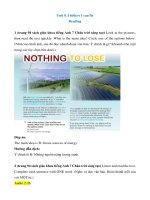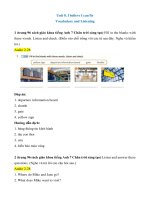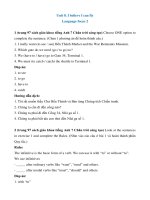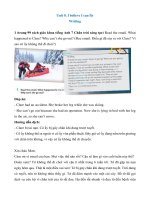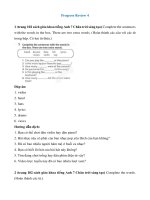Ebook Essential foundations of economics: Part 1
Bạn đang xem bản rút gọn của tài liệu. Xem và tải ngay bản đầy đủ của tài liệu tại đây (6.16 MB, 287 trang )
MyEconLab PROVIDES THE POWER OF PRACTICE
Optimize your study time with MyEconLab, the online assessment and tutorial system. When you
take a sample test online, MyEconLab gives you targeted feedback and a personalized Study Plan
to identify the topics you need to review.
Study Plan The Study Plan
consists of practice problems
taken directly from the end-ofchapter Study Plan Problems and
Applications in the textbook.
Unlimited Practice As you work each
exercise, instant feedback helps you
understand and apply the concepts. Many
Study Plan exercises contain algorithmically
generated values to ensure that you get as
much practice as you need.
Learning Resources
Study Plan problems link to learning resources that
further reinforce concepts you need to master.
• Help Me Solve This learning aids help you break
down a problem much the same way as an
instructor would do during office hours. Help Me
Solve This is available for select problems.
• Links to the eText promote reading of the
text when you need to revisit a concept or
explanation.
• Animated graphs, with audio narration,
appeal to a variety of learning styles.
• A graphing tool enables you to build and
manipulate graphs to better understand how
concepts, numbers, and graphs connect.
MyEconLab
Find out more at www.myeconlab.com
ESSENTIAL FOUNDATIONS OF ECONOMICS
delivers a complete, hands-on learning system designed
around active learning.
A Learning-by-Doing
Approach
The Checklist that begins each chapter
highlights the key topics covered and the
chapter is divided into sections that directly
correlate to the Checklist.
The Checkpoint that ends each section
provides a full page of practice problems to
encourage students to review the material
while it is fresh in their minds.
Each chapter opens with a question about a
central issue that sets the stage for the
material.
Why did the price of coffee
soar in 2010 and 2011?
4
Demand and Supply
CHAPTER CHECKLIST
When you have completed your study of this chapter,
you will be able to
1 Distinguish between quantity demanded and demand, and explain
what determines demand.
2 Distinguish between quantity supplied and supply, and explain
what determines supply.
3 Explain how demand and supply determine price and quantity in a
CHECKPOINT 4.1
Distinguish between quantity demanded and demand, and explain
what determines demand.
market, and explain the effects of changes in demand and supply.
MyEconLab
You can work these problems in
Study Plan 4.1 and get instant
feedback.
Practice Problems
The following events occur one at a time in the market for cell phones:
• The price of a cell phone falls.
• Everyone believes that the price of a cell phone will fall next month.
• The price of a call made from a cell phone falls.
• The price of a call made from a land-line phone increases.
• The introduction of camera phones makes cell phones more popular.
1.
2.
3.
Explain the effect of each event on the demand for cell phones.
Use a graph to illustrate the effect of each event.
Does any event (or events) illustrate the law of demand?
In the News
Airlines, now flush, fear a downturn
So far this year, airlines have been able to raise fares but still fill their planes.
Source: The New York Times, June 10, 2011
D
thi
li i l th t th l
fd
dd
’t
k i th
l
FIGURE 4.3
A change in any influence on buying
plans, other than a change in the price
of the good itself, changes demand
and shifts the demand curve.
ᕡ When demand decreases, the
demand curve shifts leftward from
D0 to D1.
ᕢ When demand increases, the
Confidence-Building Graphs
use color to show the direction of shifts and
detailed, numbered captions guide students
step-by-step through the action.
100% of the figures are animated in
MyEconLab, with step-by-step audio
narration.
MyEconLab Animation
Changes in Demand
demand curve shifts rightward
from D0 to D2.
Price (dollars per bottle)
2.50
Increase
in demand
2.00
1.50
1.00
D2
Decrease
in demand
0.50
D0
D1
0
6
8
10
12
14
Quantity (millions of bottles per day)
Real
Applications
Eye On Boxes apply theory to important
issues and problems that shape our global
society and individual decisions.
Eye On boxes that build off the chapter
opening question help students see the
economics behind key issues facing our
world.
EYE on the PRICE OF COFFEE
Why Did the Price of Coffee Soar in 2010 and 2011?
In January 2009, the price of coffee (the
kind that you get at Starbucks and similar coffee shops called Arabica) was
$1.25 a pound (point A in Figure 1) and
by May 2011, it had risen to $3.00 a
pound (point B).Why did the price of
coffee soar? Figure 2, which shows the
market for coffee, answers this question.
The demand curve D and the supply
curve S09 determined the equilibrium
price and quantity in 2009 at $1.25 a
pound and 950 million pounds.
Heavy rain led to exceptionally low
harvests in Colombia, Indonesia, Mexico,
and Vietnam, which decreased the
supply of coffee.The supply curve
shifted leftward to S11.The price
increased to $3.00 a pound.The
quantity demanded and equilibrium
quantity decreased to 800 million
pounds.
Price of coffee (dollars per pound)
Price (dollars per pound)
4.00
4.00
B
3.00
A
S09
B
3.00
2.00
2.00
1.25
1.00
S11 A decrease
in the supply
of coffee ...
From January 2009 to
May 2011, the price
of coffee increased
by 140 percent
... raised
the price
of coffee ...
... and
decreased
the quantity
of coffee
demanded
A
1.25
1.00
D
0
Jan 09
Jun 09
Jan 10
Jun 10
Jan 11
Jun 11
0
600
800
900
1,000 1,100 1,200
Quantity (millions of pounds per year)
Month/year
Figure 1 The price of coffee
700
Figure 2 The market for coffee
Economics
in the News
MyEconLab
To keep you informed about the latest economic news,
each day the authors upload two relevant news
articles: a microeconomic topic and a macroeconomic
topic. Each article includes discussion questions, links
to additional online resources, and references to
related textbook chapters.
Instructor Assignable Problems and Applications
Practice and
Learning Aids
in MyEconLab
An end-of-chapter problem based on the
chapter-opening issue gives students
further practice.
All of the Checkpoint problems are in
MyEconLab and available for selfassessment or instructor assignment.
Immediate feedback and problem specific
learning aids give students support when
they need it most.
1. If after heavy rain and low production, the weather improves and coffee
growers enjoy bumper crops, how does
• The demand for coffee change?
• The supply of coffee change?
• The price of coffee change?
Illustrate your answer with a graphical analysis.
2. What is the effect on the equilibrium price and equilibrium quantity of
orange juice if the price of apple juice decreases and the wage rate paid to
orange grove workers increases?
3. What is the effect on the equilibrium in the orange juice market if orange juice
becomes more popular and a cheaper robot is used to pick oranges?
Your instructor can assign these
problems as homework, a quiz,
or a test in MyEconLab .
This page intentionally left blank
Essential Foundations of
ECONOMICS
Robin Bade
Michael Parkin
University of Western Ontario
SIXTH EDITION
Boston Columbus Indianapolis New York San Francisco Upper Saddle River
Amsterdam Cape Town Dubai London Madrid Milan Munich Paris Montréal Toronto
Delhi Mexico City Sao Paulo Sydney Hong Kong Seoul Singapore Taipei Tokyo
Editor in Chief: Donna Battista
Executive Acquisitions Editor: Adrienne
D’Ambrosio
Editorial Project Manager: Sarah Dumouchelle
Editorial Assistant: Elissa Senra-Sargent
Executive Marketing Manager: Lori DeShazo
Senior Managing Editor: Nancy Fenton
Production Project Manager: Nancy Freihofer
Media Publisher: Denise Clinton
Content Lead for MyEconLab: Noel Lotz
Senior Media Producer: Melissa Honig
Image Permission Manager: Rachel Youdelman
Photo Researcher: Amy Dunleavy
Art Director, Cover: Jonathan Boylan
Cover Image: Elwynn/Dreamstime.com
Copyeditor: Catherine Baum
Technical Illustrator: Richard Parkin
Project Management, Page Makeup,
Design: Integra
Printer/Binder: Courier/Kendallville
Cover Printer: Courier/Kendallville
Text Font: 10/12, Palatino-Roman
Credits and acknowledgments borrowed from other sources and reproduced, with permission, in this
textbook appear on the appropriate page within text and on pages C-1–C-2.
Copyright © 2013, 2011, 2009, 2007, 2004 by Pearson Education, Inc., publishing as Addison-Wesley.
All rights reserved. Manufactured in the United States of America.This publication is protected by
Copyright, and permission should be obtained from the publisher prior to any prohibited reproduction, storage in a retrieval system, or transmission in any form or by any means, electronic, mechanical,
photocopying, recording, or likewise.To obtain permission(s) to use material from this work, please
submit a written request to Pearson Education, Inc., Permissions Department, One Lake Street, Upper
Saddle River, New Jersey 07458, or you may fax your request to 201-236-3290.
Many of the designations by manufacturers and sellers to distinguish their products are claimed as
trademarks.Where those designations appear in this book, and the publisher was aware of a trademark claim, the designations have been printed in initial caps or all caps.
Library of Congress Cataloging-in-Publication Data
Bade, Robin.
Essentials of economics/Robin Bade, Michael Parkin.—6th ed.
p. cm.
Includes index.
ISBN-13: 978-0-13-283311-0
ISBN-10: 0-13-283311-5
1. Economics. I. Parkin, Michael, 1939– II. Title.
HB171.5.B155 2013
330—dc23
2011045330
10 9 8 7 6 5 4 3 2 1
ISBN 10:
0-13-283311-5
ISBN 13: 978-0-13-283311-0
To Erin, Tessa, Jack, Abby, and Sophie
This page intentionally left blank
About the Authors
Robin Bade was an undergraduate at the University of Queensland,
Australia, where she earned degrees in mathematics and economics. After a spell
teaching high school math and physics, she enrolled in the Ph.D. program at the
Australian National University, from which she graduated in 1970. She has held
faculty appointments at the University of Edinburgh in Scotland, at Bond
University in Australia, and at the Universities of Manitoba, Toronto, and
Western Ontario in Canada. Her research on international capital flows appears
in the International Economic Review and the Economic Record.
Robin first taught the principles of economics course in 1970 and has taught
it (alongside intermediate macroeconomics and international trade and finance)
most years since then. She developed many of the ideas found in this text while
conducting tutorials with her students at the University of Western Ontario.
Michael Parkin studied economics in England and began his university teaching career immediately after graduating with a B.A. from the University
of Leicester. He learned the subject on the job at the University of Essex,
England’s most exciting new university of the 1960s, and at the age of 30 became
one of the youngest full professors. He is a past president of the Canadian
Economics Association and has served on the editorial boards of the American
Economic Review and the Journal of Monetary Economics. His research on macroeconomics, monetary economics, and international economics has resulted in more
than 160 publications in journals and edited volumes, including the American
Economic Review, the Journal of Political Economy, the Review of Economic Studies,
the Journal of Monetary Economics, and the Journal of Money, Credit, and Banking. He
is author of the best-selling textbook, Economics (Addison-Wesley), now in its
Ninth Edition.
Robin and Michael are a wife-and-husband team. Their most notable joint
research created the Bade-Parkin Index of central bank independence and
spawned a vast amount of research on that topic. They don’t claim credit for the
independence of the new European Central Bank, but its constitution and the
movement toward greater independence of central banks around the world
were aided by their pioneering work. Their joint textbooks include
Macroeconomics (Prentice-Hall), Modern Macroeconomics (Pearson Education
Canada), and Economics: Canada in the Global Environment, the Canadian adaptation of Parkin, Economics (Addison-Wesley). They are dedicated to the challenge
of explaining economics ever more clearly to an ever-growing body of students.
Music, the theater, art, walking on the beach, and five fast-growing grandchildren provide their relaxation and fun.
ix
This page intentionally left blank
Brief Contents
ECONOMICS
PART 1
INTRODUCTION
1 Getting Started, 1
2 The U.S. and Global Economies,
3 The Economic Problem, 59
4 Demand and Supply, 83
31
PART 2
A CLOSER LOOK AT MARKETS
5 Elasticities of Demand and Supply, 111
6 Efficiency and Fairness of Markets, 137
7 Government Actions in Markets, 167
8 Global Markets in Action, 195
9 Externalities: Pollution, Education,
and Health Care, 223
PART 3
PRICES, PROFITS, AND INDUSTRY PERFORMANCE
10 Production and Cost, 249
11 Perfect Competition, 277
12 Monopoly, 305
13 Monopolistic Competition and Oligopoly, 337
PART 4
MONITORING THE MACROECONOMY
14 GDP: A Measure of Total Production
and Income, 367
15 Jobs and Unemployment, 397
16 The CPI and the Cost of Living, 419
PART 5
UNDERSTANDING THE MACROECONOMY
17 Potential GDP and the Economic Growth, 443
18 Money and the Monetary System, 475
19 Aggregate Supply and Aggregate Demand, 505
20 Fiscal Policy and Monetary Policy, 531
Glossary G-1
Index I-1
Credits C-1
xi
This page intentionally left blank
Contents
PA R T 1
CHAPTER
INTRODUCTION
1
CHAPTER
Getting Started
CHAPTER CHECKLIST
1.1
1.2
The U.S. and Global Economies
1
CHAPTER CHECKLIST
1
2.1
Definition and Questions
2
Scarcity, 2
Economics Defined, 2
What, How, and For Whom? 3
When Is the Pursuit of Self-Interest in
the Social Interest? 4
CHECKPOINT 1.1
Economic Ideas, 8
A Choice Is a Tradeoff, 8
Rational Choice, 8
Benefit: What You Gain, 9
Cost: What You Must Give Up, 9
How Much? Choosing at the Margin,
Choices Respond to Incentives, 11
Economics as Social Science, 12
Economics as Policy Tool, 14
CHAPTER SUMMARY
2.2
8
10
16
18
Appendix: Making and Using Graphs
21
Interpreting Data Graphs, 22
Interpreting Graphs Used in Economic Models, 24
The Slope of a Relationship, 27
Relationships Among More Than Two Variables, 28
APPENDIX CHECKPOINT
2.3
37
The Global Economy
39
The People, 39
The Countries, 39
What in the Global Economy? 40
How in the Global Economy? 42
For Whom in the Global Economy?
43
45
The Circular Flows
46
Households and Firms, 46
Markets, 46
Real Flows and Money Flows, 46
Governments, 48
Governments in the Circular Flow, 49
Federal Government Expenditures
and Revenue, 50
State and Local Government Expenditures
and Revenue, 51
Circular Flows in the Global Economy, 52
CHECKPOINT 2.3
CHAPTER SUMMARY
54
55
CHAPTER CHECKPOINT
30
32
38
CHECKPOINT 2.2
17
CHAPTER CHECKPOINT
What, How, and For Whom?
CHECKPOINT 2.1
56
■ EYE on the PAST
■ EYE on the U.S. ECONOMY
Adam Smith and the Birth of Economics as a Social
Science, 13
What We Produce,
■ EYE on the PAST
■ EYE on the BENEFIT AND COST
OF SCHOOL
Changes in What We Produce,
Did You Make the Right Decision?
Changes in How We Produce in the Information
Economy, 36
15
31
31
What Do We Produce? 32
How Do We Produce? 34
For Whom Do We Produce?
7
The Economic Way of Thinking
CHECKPOINT 1.2
2
33
34
■ EYE on the U.S. ECONOMY
xiii
xiv
CONTENTS
■ EYE on the iPHONE
■ EYE on the U.S. ECONOMY
Who Makes the iPhone?
No One Knows How to Make a Pencil,
41
■ EYE on YOUR LIFE
73
■ EYE on YOUR LIFE
The U.S. and Global Economies in Your Life,
45
Your Comparative Advantage,
76
■ EYE on the PAST
Growing Government,
52
■ EYE on the GLOBAL ECONOMY
The Ups and Downs in International Trade,
CHAPTER
4
Demand and Supply
54
CHAPTER CHECKLIST
CHAPTER
3
Competitive Markets
The Economic Problem
CHAPTER CHECKLIST
3.1
60
Production Possibilities Frontier, 60
71
72
Specialization and Trade
CHAPTER SUMMARY
4.3
78
79
CHAPTER CHECKPOINT
80
Your Production Possibilities Frontier,
■ EYE on the ENVIRONMENT
68
98
Market Equilibrium
99
Price: A Market’s Automatic Regulator, 99
Predicting Price Changes: Three Questions, 100
Effects of Changes in Demand, 101
Effects of Changes in Supply, 102
Changes in Both Demand and Supply, 104
106
107
CHAPTER CHECKPOINT
108
■ EYE on the PRICE OF COFFEE
■ EYE on the U.S. ECONOMY
Guns Versus Butter,
92
The Law of Supply, 92
Supply Schedule and Supply Curve, 92
Individual Supply and Market Supply, 94
Changes in Supply, 95
Change in Quantity Supplied Versus Change
in Supply, 97
CHAPTER SUMMARY
64
91
Supply
CHECKPOINT 4.3
■ EYE on YOUR LIFE
Is Wind Power Free?
85
The Law of Demand, 85
Demand Schedule and Demand Curve, 85
Individual Demand and Market Demand, 87
Changes in Demand, 88
Change in Quantity Demanded Versus Change in
Demand, 90
CHECKPOINT 4.2
73
Comparative Advantage, 74
Achieving Gains from Trade, 76
CHECKPOINT 3.4
4.2
84
Demand
CHECKPOINT 4.1
70
Economic Growth
CHECKPOINT 3.3
3.4
65
Opportunity Cost 66
The Opportunity Cost of a Cell Phone, 66
Opportunity Cost and the Slope of the PPF, 67
Opportunity Cost Is a Ratio, 67
Increasing Opportunity Costs Are Everywhere, 68
Your Increasing Opportunity Cost, 68
CHECKPOINT 3.2
3.3
4.1
Production Possibilities
CHECKPOINT 3.1
3.2
59
59
83
83
Why Did the Price of Coffee Soar in 2010
and 2011? 103
69
■ EYE on the GLOBAL ECONOMY
■ EYE on YOUR LIFE
Hong Kong’s Rapid Economic Growth,
Using Demand and Supply,
72
103
CONTENTS
PA R T 2
CHAPTER
5.1
A C L O S E R L O O K AT M A R K E T S
5
CHAPTER
Elasticities of Demand
and Supply 111
Efficiency and Fairness
of Markets 137
CHAPTER CHECKLIST
CHAPTER CHECKLIST
111
The Price Elasticity of Demand
112
Percentage Change in Price, 112
Percentage Change in Quantity Demanded, 113
Elastic and Inelastic Demand, 114
Influences on the Price Elasticity of Demand, 114
Computing the Price Elasticity of Demand, 116
Interpreting the Price Elasticity of Demand
Number, 117
Elasticity Along a Linear Demand Curve, 118
Total Revenue and the Price Elasticity of
Demand, 120
Applications of the Price Elasticity of
Demand, 122
CHECKPOINT 5.1
5.2
123
The Price Elasticity of Supply
CHECKPOINT 5.2
CHAPTER SUMMARY
6.2
CHECKPOINT 6.2
6.3
Cost, Price, and Producer Surplus
CHECKPOINT 6.3
151
152
Marginal Benefit Equals Marginal Cost,
Total Surplus Is Maximized, 153
The Invisible Hand, 153
Market Failure, 155
Sources of Market Failure, 156
Alternatives to the Market, 157
158
162
163
CHAPTER CHECKPOINT
164
■ EYE on the U.S. ECONOMY
■ EYE on the PRICE OF GAS
The Invisible Hand and e-Commerce,
What Do You Do When the Price of Gasoline
Rises? 121
■ EYE on PRICE GOUGING
Should Price Gouging Be Illegal?
■ EYE on YOUR LIFE
■ EYE on YOUR LIFE
Your Price Elasticities of Demand,
131
152
Are Markets Fair? 159
It’s Not Fair If the Rules Aren’t Fair, 159
It’s Not Fair If the Result Isn’t Fair, 159
Compromise, 161
CHAPTER SUMMARY
119
149
149
Are Markets Efficient?
CHECKPOINT 6.5
■ EYE on the GLOBAL ECONOMY
146
146
148
Supply and Marginal Cost,
Producer Surplus, 150
6.5
134
Price Elasticities of Demand,
Value, Price, and Consumer Surplus
CHECKPOINT 6.4
132
138
145
Demand and Marginal Benefit,
Consumer Surplus, 147
126
133
CHAPTER CHECKPOINT
Allocation Methods and Efficiency
CHECKPOINT 6.1
128
Cross Elasticity of Demand, 129
Income Elasticity of Demand, 130
137
Resource Allocation Methods, 138
Using Resources Efficiently, 141
6.4
Cross Elasticity and Income
Elasticity 129
CHECKPOINT 5.3
6.1
124
Elastic and Inelastic Supply, 124
Influences on the Price Elasticity of
Supply, 124
Computing the Price Elasticity of Supply,
5.3
6
154
160
Allocation Methods, Efficiency, and Fairness,
161
xv
xvi
CONTENTS
CHAPTER
7
CHAPTER
Global Markets in Action
Government Actions
in Markets 167
CHAPTER CHECKLIST
7.1
7.2
8.1
8.2
173
174
A Rent Ceiling, 174
Are Rent Ceilings Efficient? 177
Are Rent Ceilings Fair? 178
If Rent Ceilings Are So Bad, Why Do We
Have Them? 178
Price Supports in Agriculture
187
How Governments Intervene in Markets
for Farm Products, 187
Price Support: An Illustration, 187
CHECKPOINT 7.4
CHAPTER SUMMARY
8.3
204
International Trade Restrictions
Tariffs, 205
Import Quotas, 209
Other Import Barriers, 211
Export Subsidies, 211
CHECKPOINT 8.3
8.4
212
The Case Against Protection
Three Traditional Arguments for
Protection, 213
Four Newer Arguments
for Protection, 215
Why Is International Trade
Restricted? 216
CHECKPOINT 8.4
CHAPTER SUMMARY
218
219
220
U.S. Exports and Imports,
■ EYE on the U.S. ECONOMY
The Federal Minimum Wage,
200
■ EYE on the U.S. ECONOMY
192
183
Who Wins and Who Loses from
Globalization? 201
■ EYE on the PAST
Can the President Repeal the Laws of Supply
and Demand? 185
The History of U.S. Tariffs,
■ EYE on YOUR LIFE
International Trade,
189
197
■ EYE on GLOBALIZATION
■ EYE on PRICE REGULATION
Price Ceilings and Price Floors,
198
Winners, Losers, and Net Gains
from Trade 201
CHAPTER CHECKPOINT
190
191
CHAPTER CHECKPOINT
196
International Trade Today, 196
What Drives International Trade? 196
Why the United States Imports T-Shirts,
Why the United States Exports
Airplanes, 199
CHECKPOINT 8.2
Price Floors
186
195
Gains and Losses from Imports, 202
Gains and Losses from Exports, 203
179
180
The Minimum Wage, 181
Is the Minimum Wage Efficient? 184
Is the Minimum Wage Fair? 185
If the Minimum Wage Is So Bad, Why Do
We Have It? 185
195
How Global Markets Work
CHECKPOINT 8.1
Price Ceilings
CHECKPOINT 7.3
7.4
167
168
Tax Incidence, 168
Taxes and Efficiency, 169
Incidence, Inefficiency, and Elasticity, 170
Incidence, Inefficiency, and the Elasticity
of Demand, 171
Incidence, Inefficiency, and the Elasticity
of Supply, 172
CHECKPOINT 7.2
7.3
CHAPTER CHECKLIST
Taxes on Buyers and Sellers
CHECKPOINT 7.1
8
■ EYE on YOUR LIFE
217
205
213
205
CONTENTS
CHAPTER
9
9.2
Externalities: Pollution,
Education, and
Health Care 223
CHAPTER CHECKLIST
Private Benefits and Social Benefits, 236
Government Actions in the Face of External
Benefits, 238
CHECKPOINT 9.2
223
Externalities in Our Daily Lives
CHAPTER SUMMARY
224
Negative Production Externalities, 224
Positive Production Externalities, 224
Negative Consumption Externalities, 225
Positive Consumption Externalities, 225
9.1
Positive Externalities: Education
and Health Care 236
244
245
CHAPTER CHECKPOINT
246
■ EYE on the U.S. ECONOMY
U.S. Air Pollution Trends,
233
■ EYE on CLIMATE CHANGE
Negative Externalities:
Pollution 226
How Can We Limit Climate Change?
Private Costs and Social Costs, 226
Production and Pollution:
How Much? 228
Property Rights, 229
The Coase Theorem, 230
Government Actions in the Face
of External Costs, 231
Switching to Clean Technologies, 233
Education Quality: Charter Schools and
Vouchers, 241
CHECKPOINT 9.1
PA R T 3
CHAPTER
234
■ EYE on the U.S. ECONOMY
■ EYE on YOUR LIFE
Externalities in Your Life,
241
■ EYE on HEALTH CARE
Does Health Care Need Fixing?
242
235
PRICES, PROFITS, AND INDUSTRY PERFORMANCE
10
Production and Cost
CHAPTER CHECKLIST
249
10.1 Economic Cost and Profit
The Firm’s Goal, 250
Accounting Cost and Profit,
Opportunity Cost, 250
Economic Profit, 251
CHECKPOINT 10.1
Total Product, 255
Marginal Product, 256
Average Product, 258
Total Cost, 261
Marginal Cost, 262
260
261
Average Cost, 263
Why the Average Total Cost Curve
Is U-Shaped, 265
Cost Curves and Product Curves, 266
Shifts in the Cost Curves, 266
CHECKPOINT 10.3
268
10.4 Long-Run Cost
269
Plant Size and Cost, 269
The Long-Run Average Cost Curve,
253
10.2 Short-Run Production
10.3 Short-Run Cost
250
250
CHECKPOINT 10.4
SHORT RUN AND LONG RUN
CHECKPOINT 10.2
249
255
254
CHAPTER SUMMARY
270
272
273
CHAPTER CHECKPOINT
274
■ EYE on YOUR LIFE
Your Average and Marginal Grades,
259
■ EYE on RETAILERS’ COSTS
Which Store Has the Lower Costs: Wal-Mart
or 7–Eleven? 271
xvii
xviii
CONTENTS
CHAPTER
11
12.2 Single-Price Monopoly
Perfect Competition
CHAPTER CHECKLIST
310
Price and Marginal Revenue, 310
Marginal Revenue and Elasticity, 311
Output and Price Decision, 312
277
277
CHECKPOINT 12.2
Market Types
278
Perfect Competition, 278
Other Market Types, 278
12.3 Monopoly and Competition Compared
11.1 A Firm’s Profit-Maximizing Choices
Price Taker, 279
Revenue Concepts, 279
Profit-Maximizing Output, 280
Marginal Analysis and the Supply Decision,
Temporary Shutdown Decision, 283
The Firm’s Short-Run Supply Curve, 284
CHECKPOINT 11.1
Output and Price, 315
Is Monopoly Efficient? 316
Is Monopoly Fair? 317
Rent Seeking, 317
Create a Monopoly by Rent Seeking,
Rent-Seeking Equilibrium, 318
279
282
CHECKPOINT 12.3
Market Supply in the Short Run, 287
Short-Run Equilibrium in Normal Times, 288
Short-Run Equilibrium in Good Times, 289
Short-Run Equilibrium in Bad Times, 290
CHECKPOINT 12.4
Entry and Exit, 293
The Effects of Exit, 294
Change in Demand, 295
Technological Change, 295
Is Perfect Competition Efficient? 298
Is Perfect Competition Fair? 299
CHAPTER SUMMARY
332
333
CHAPTER CHECKPOINT
334
■ EYE on the U.S. ECONOMY
300
Airline Price Discrimination,
324
■ EYE on MICROSOFT
302
Are Microsoft’s Prices Too High?
329
■ EYE on YOUR LIFE
■ EYE on the AUTO INDUSTRY
Why Did GM Fail?
292
326
Efficient Regulation of a Natural
Monopoly, 326
Second-Best Regulation of a Natural
Monopoly, 327
CHECKPOINT 12.5
301
CHAPTER CHECKPOINT
325
12.5 Monopoly Regulation
291
11.3 Output, Price, and Profit in the Long Run
CHAPTER SUMMARY
319
320
Price Discrimination and Consumer
Surplus, 320
Profiting by Price Discriminating, 321
Perfect Price Discrimination, 322
Price Discrimination and Efficiency, 324
11.2 Output, Price, and Profit in the
Short Run 287
CHECKPOINT 11.3
318
12.4 Price Discrimination
286
CHECKPOINT 11.2
314
Monopoly in Your Everyday Life,
296
331
■ EYE on YOUR LIFE
The Perfect Competition that You Encounter,
299
CHAPTER
CHAPTER
Monopolistic Competition
and Oligopoly 337
12
Monopoly
13
305
CHAPTER CHECKLIST
CHAPTER CHECKLIST
12.1 Monopoly and How it Arises
How Monopoly Arises, 306
Monopoly Price-Setting Strategies,
CHECKPOINT 12.1
337
305
309
13.1 What Is Monopolistic Competition?
306
308
Large Number of Firms, 338
Product Differentiation, 338
Competing on Quality, Price,
and Marketing, 338
338
315
CONTENTS
Entry and Exit, 339
Identifying Monopolistic Competition, 339
Output and Price in Monopolistic Competition,
The Firm’s Profit-Maximizing Decision, 341
Long Run: Zero Economic Profit, 342
Monopolistic Competition and Perfect
Competition, 343
CHECKPOINT 13.1
CHECKPOINT 13.4
CHAPTER SUMMARY
344
13.2 Product Development and Marketing
Innovation and Product Development,
Marketing, 346
CHECKPOINT 13.2
341
The Duopolists’ Dilemma, 357
Advertising and Research Games
in Oligopoly, 358
Repeated Games, 360
Is Oligopoly Efficient? 361
345
345
362
363
CHAPTER CHECKPOINT
364
■ EYE on the U.S. ECONOMY
Examples of Monopolistic Competition,
349
■ EYE on CELL PHONES
350
Collusion, 350
Duopoly in Airplanes, 351
The Duopolists’ Dilemma, 352
Which Cell Phone?
CHECKPOINT 13.3
A Game You Might Play,
13.3 Oligopoly
Some Selling Costs You Pay,
348
■ EYE on YOUR LIFE
354
360
■ EYE on the CHIPS DUOPOLY
355
What Is a Game? 355
The Prisoners’ Dilemma,
CHAPTER
346
■ EYE on YOUR LIFE
13.4 Game Theory
PA R T 4
340
Are Two Computer Chip-Makers Too Few?
361
355
MONITORING THE MACROECONOMY
14
GDP: A Measure of Total
Production and Income
CHAPTER CHECKLIST
367
CHECKPOINT 14.3
367
14.1 GDP, Income, and Expenditure
GDP Defined, 368
Circular Flows in the U.S. Economy,
Expenditure Equals Income, 370
CHECKPOINT 14.1
The Standard of Living Among Countries, 384
Goods and Services Omitted from GDP, 385
Other Influences on the Standard of Living, 386
CHAPTER SUMMARY
390
Appendix: Measuring Real GDP
393
The Problem with Base-Year Prices, 393
Value Production in the Prices of Adjacent
Years, 393
369
372
APPENDIX CHECKPOINT
14.2 Measuring U.S. GDP
373
The Expenditure Approach, 373
The Income Approach, 375
GDP and Related Measures of Production
and Income, 377
Real GDP and Nominal GDP, 378
Calculating Real GDP, 378
Using the Real GDP Numbers, 379
CHECKPOINT 14.2
389
CHAPTER CHECKPOINT
368
388
■ EYE on the U.S. ECONOMY
Is a Computer Program an Intermediate Good
or a Final Good? 374
■ EYE on the BOOMS AND BUSTS
How Do We Track the Booms and Busts of Our
Economy, 384
■ EYE on YOUR LIFE
380
Making GDP Personal,
14.3 The Uses and Limitations of Real GDP
The Standard of Living Over Time, 381
Tracking the Course of the Business Cycle,
396
382
381
386
■ EYE on the GLOBAL ECONOMY
Which Country Has the Highest Standard
of Living? 387
xix
xx
CONTENTS
CHAPTER
15
CHAPTER
Jobs and Unemployment
CHAPTER CHECKLIST
397
397
398
Current Population Survey, 398
Population Survey Criteria, 398
Two Main Labor Market Indicators, 399
Alternative Measures of
Unemployment, 400
402
419
16.1 The Consumer Price Index
420
Reading the CPI Numbers, 420
Constructing the CPI, 420
The CPI Market Basket, 420
The Monthly Price Survey, 421
Calculating the CPI, 422
Measuring Inflation and Deflation,
CHECKPOINT 16.1
15.2 Labor Market Trends
and Fluctuations 403
423
425
16.2 The CPI and Other Price Level
Measures 426
Unemployment Rate, 403
The Participation Rate, 404
Alternative Measures
of Unemployment, 406
A Closer Look at Part-Time
Employment, 407
CHECKPOINT 15.2
The CPI and the Cost
of Living 419
CHAPTER CHECKLIST
15.1 Labor Market Indicators
CHECKPOINT 15.1
16
Sources of Bias in the CPI, 426
The Magnitude of the Bias, 427
Two Consequences of the CPI Bias, 428
Alternative Measures of the Price Level
and Inflation Rate, 429
408
CHECKPOINT 16.2
15.3 Unemployment and
Full Employment 409
431
16.3 Nominal and Real Values
Frictional Unemployment, 409
Structural Unemployment, 409
Cyclical Unemployment, 410
“Natural” Unemployment, 410
Unemployment and Real GDP, 411
432
Dollars and Cents at Different Dates, 432
Nominal and Real Values in
Macroeconomics, 433
Nominal GDP and Real GDP, 433
Nominal Wage Rate and Real Wage Rate, 434
Nominal Interest Rate and Real Interest Rate, 436
CHECKPOINT 15.3
CHECKPOINT 16.3
CHAPTER SUMMARY
414
415
CHAPTER CHECKPOINT
CHAPTER SUMMARY
416
438
439
CHAPTER CHECKPOINT
440
■ EYE on the U.S. ECONOMY
■ EYE on The PAST
The Current Population Survey,
700 Years of Inflation and Deflation,
401
■ EYE on the GLOBAL ECONOMY
■ EYE on the U.S. ECONOMY
Unemployment Around
the World, 404
Deflating the GDP Balloon,
■ EYE on the GLOBAL ECONOMY
Women in the Labor Force,
405
■ EYE on the UNEMPLOYED
How Long Does It Take to Find a Job?
■ EYE on YOUR LIFE
Your Labor Market Status
and Activity, 412
424
433
■ EYE on the PAST
The Nominal and Real Wage Rates of Presidents
of the United States, 435
■ EYE on BOX OFFICE HITS
410
Which Movie Really Was the Biggest Box
Office Hit? 436
■ EYE on YOUR LIFE
A Student’s CPI,
437
CONTENTS
PA R T 5
CHAPTER
xxi
U N D E R S TA N D I N G T H E M A C R O E C O N O M Y
17
■ EYE on YOUR LIFE
Potential GDP and the Economic
Growth 443
CHAPTER CHECKLIST
443
CHAPTER
Macroeconomic Approaches
and Pathways 443
The Three Main Schools of Thought,
Today’s Consensus, 445
The Road Ahead, 446
447
The Production Function,
The Labor Market, 449
444
CHAPTER CHECKLIST
476
Definition of Money, 476
The Functions of Money, 476
Money Today, 478
Official Measures of Money: M1 and M2, 478
Checks, Credit Cards, Debit Cards, and E-Checks,
An Embryonic New Money: E-Cash, 480
455
Calculating Growth Rates, 456
The Magic of Sustained Growth,
CHECKPOINT 17.2
456
CHECKPOINT 18.1
457
460
Labor Productivity, 460
Saving and Investment in Physical Capital, 460
Expansion of Human Capital and Discovery
of New Technologies, 462
Combined Influences Bring Labor Productivity
Growth, 463
CHECKPOINT 18.2
487
The Structure of the Federal Reserve, 487
The Fed’s Policy Tools, 488
How the Fed’s Policy Tools Work, 489
466
CHECKPOINT 18.3
467
Preconditions for Economic Growth, 467
Policies to Achieve Faster Growth, 468
How Much Difference Can Policy Make? 469
491
Creating Deposits by Making Loans, 491
How Open Market Operations Change
the Monetary Base, 493
The Multiplier Effect of an Open Market Operation, 496
The Money Multiplier, 497
470
472
CHECKPOINT 18.4
■ EYE on the U.S. ECONOMY
The Lucas Wedge and the Okun Gap,
490
18.4 Regulating the Quantity of Money
471
CHAPTER CHECKPOINT
486
18.3 The Federal Reserve System
17.4 Achieving Faster Growth
CHAPTER SUMMARY
482
Commercial Banks, 482
Thrift Institutions, 485
Money Market Funds, 485
17.3 labor productivity Growth
CHECKPOINT 17.4
CHAPTER SUMMARY
446
500
501
CHAPTER CHECKPOINT
■ EYE on the GLOBAL ECONOMY
502
Potential GDP in the United States and European
Union, 447
■ EYE on the PAST
■ EYE on U.S. POTENTIAL GDP
■ EYE on the U.S. ECONOMY
Why Do American Earn More and Produce
More Than Europeans? 454
Commercial Banks Under Stress in the Financial
Crisis, 485
■ EYE on the GLOBAL ECONOMY
Why Are Some Nations Rich and Others Poor?
479
481
18.2 The Banking System
459
CHECKPOINT 17.3
475
18.1 What Is Money?
448
17.2 The Basics of Economic Growth
18
Money and the Monetary
System 475
17.1 Potential GDP
CHECKPOINT 17.1
How You Influence and Are Influenced by Economic
Growth, 465
The “Invention” of Banking,
483
■ EYE on YOUR LIFE
458
Money and Your Role in Its Creation,
491
xxii
CONTENTS
■ EYE on CREATING MONEY
How Does the Fed Create Money and Regulate
Its Quantity? 498
CHAPTER
19
Aggregate Supply and Aggregate
Demand 505
CHAPTER CHECKLIST
505
19.1 Aggregate Supply
506
Aggregate Supply Basics, 506
Changes in Aggregate Supply, 509
CHECKPOINT 19.1
19.2 Aggregate Demand
512
Aggregate Demand Basics, 512
Changes in Aggregate Demand, 514
The Aggregate Demand Multiplier, 516
Federal Revenues, Outlays, Deficits,
and Debt, 534
■ EYE on the U.S. ECONOMY
A Social Security and Medicare Time Bomb,
■ EYE on the U.S. ECONOMY
The U.S. Structural and Cyclical Budget
Balances, 541
■ EYE on the FISCAL STIMULUS
527
Can Fiscal Stimulus End a Recession?
528
U.S. Economic Growth, Inflation, and the Business
Cycle 502
■ EYE on YOUR LIFE
Did the Fed Save Us From Another Great
Depression? 550
■ EYE on YOUR LIFE
Fiscal and Monetary Policy and How They
Affect You, 551
524
■ EYE on the BUSINESS CYCLE
Why Did the U.S. Economy Go into Recession
in 2008? 525
Glossary G-1
Index I-1
Credits C-1
20
Fiscal Policy and Monetary
Policy 531
CHAPTER CHECKLIST
531
20.1 The Federal Budget and Fiscal Policy
The Federal Budget,
532
542
■ EYE on THE FED IN A CRISIS
■ EYE on the U.S. ECONOMY
CHAPTER
554
■ EYE on the PAST
526
Using the AS-AD Model
552
553
CHAPTER CHECKPOINT
Macroeconomic Equilibrium, 518
Three Types of Macroeconomic Equilibrium, 519
Economic Growth and Inflation Trends, 520
The Business Cycle, 521
Inflation Cycles, 522
Deflation and the Great Depression, 524
CHAPTER CHECKPOINT
20.2 The Federal Reserve and Monetary
Policy 544
CHAPTER SUMMARY
19.3 Explaining Economic Trends
and Fluctuations 518
CHAPTER SUMMARY
543
CHECKPOINT 20.2
517
CHECKPOINT 19.3
CHECKPOINT 20.1
The Monetary Policy Process, 544
The Federal Funds Rate Target, 545
The Ripple Effects of the Fed’s Actions, 546
Monetary Stabilization in the AS–AD Model, 548
The Fed Eases to Fight Recession, 548
Limitations of Monetary Stabilization Policy, 551
511
CHECKPOINT 19.2
Discretionary Fiscal Policy: Demand-Side Effects, 535
Discretionary Fiscal Policy: Supply-Side Effects, 537
Limitations of Discretionary Fiscal Policy, 539
Automatic Fiscal Policy, 540
Cyclical and Structural Budget Balances, 540
Schools of Thought and Cracks in Today’s
Consensus, 541
532
539
Preface
Students know that throughout their lives they will make
economic decisions and be influenced by economic forces.
They want to understand the economic principles that can help
them navigate these forces and guide their decisions. Essential
Foundations of Economics is our attempt to satisfy this want.
The response to our earlier editions from hundreds of
colleagues across the United States and throughout the world
tells us that most of you agree with our view that to achieve its goals, the principles course must do four things well. It must
•
•
•
•
Motivate with compelling issues and questions
Focus on core ideas
Steer a path between an overload of detail and too much left unsaid
Encourage and aid learning by doing
The Foundations icon with its four blocks (on the cover and throughout the
book) symbolizes this four-point approach that has guided all our choices in writing this text and creating its comprehensive teaching and learning supplements.
WHAT’S NEW IN THE SIXTH EDITION
The extraordinary events in the U.S. and global economies provide a rich display
of economic forces in action through which students can be motivated to
discover the economic way of thinking. The global financial crisis, slump, and
faltering recovery; ongoing tensions that result from globalization and international outsourcing; the continued spectacular expansion of China and India in
the information-age economy; enhanced concern about climate change;
relentless pressure on the federal budget from the demands of an aging population and increased defense and homeland security expenditures; the dilemma
posed by slow recovery and rising government debt; and the ever-growing
federal budget deficit and national debt are just a few of these interest-arousing
events. All of them feature at the appropriate points in our new edition, and the
text and examples are all thoroughly updated to reflect the most recently
available data and events.
xxiii
xxiv
PREFACE
Every chapter contains many small changes, all designed to enhance clarity
and currency. We have also made a few carefully selected major changes that we
describe below.
New Features
We have simplified the chapter openers to grab student attention and provide
instant focus for the chapter. Each chapter opens with a question about a central
issue that the chapter addresses and is illustrated with a carefully selected photograph. An Eye On box returns to and discusses the question and an end-of-chapter
problem, that is also in the MyEconLab Homework and Test Manager, makes the
issue available for assignment with automatic grading. This feature enables the
student to get the point of the chapter quickly; ties the chapter together; and enables the instructor to focus on a core issue in class and for practice.
The Chapter Checkpoint (the last three pages of each chapter) has been thoroughly revised. The first page contains problems and applications for the student to work, which are replicated in the MyEconLab Study Plan. The second
page contains problems and applications for the instructor to assign for homework, quiz, or test. Many of these problems and applications are new to the
sixth edtion and include mini case studies from recent news stories. The third
page contains a short multiple choice quiz. This quiz, also available in
MyEconLab for student practice, hits the high points of the chapter and enables
students to test themselves on the types of questions they are likely to encounter
on tests and exams.
The Checkpoints at the end of each major section of a chapter have been
reorganized to separate practice with basic analysis and “In the News” applications. Worked solutions are provided for both types of questions.
Major Content Changes in Introductory Chapters
You’re in school! Did you make the right decision? Who makes the iPhone? Is
wind power free? Why did the price of coffee soar in 2010 and 2011? These are
the questions that motivate the four introductory chapters.
We reworked Chapter 1 to strengthen the explanation and illustration of the
economic way of thinking by placing the student center stage and focusing on
the decision to remain in school or get a full-time job. Our goal is to engage the
student from the outset of the course, grab attention, and show the relevance of
economics and its place in everyday life. We also revised and improved our
explanation of the scientific method in economics.
Chapter 3 has a more gradual and fully illustrated explanation of the mutual
gains from trade arising from comparative advantage and a new Eye On box on
the power of specialization and trade through the classic story of the production
of the pencil.
Major Content Changes in Micro Chapters (Parts 2 and 3)
What do you do when the price of gasoline rises? Should price gouging be
illegal? Can the President repeal the laws of supply and demand? Who wins
and who loses from globalization? How can we limit climate change? Does
health care need fixing? Which store has the lower costs: Wal-Mart or 7-Eleven?
Why did GM fail? Are Microsoft’s prices too high? Which cell phone? Are two

